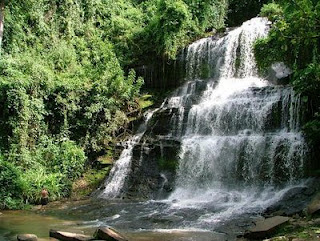Kumasi is the second largest city in Ghana and is substantially different from Accra. The center of town is built on a series of hills surrounding a natural bowl shaped valley. Over a million people live in the area and the city is very centralized and quite chaotic. It's a good place to walk around and (we're guessing here) not the best place to drive. Many taxis will outright refuse to go to a destination that requires crossing the central traffic circle (and for good reasons). Just northwest of the center is the sprawling national arts center. Sort of a laid-back destination, there are a series of buildings where traditional Ashanti crafts are practiced (pottery, weaving, sculpture etc..) and another series of buildings where they are sold, although which is which can be difficult to determine. There is also a pleasant café and assorted shady resting spots.

.jpg)
Kumasi market
The center of town - Kejetia - is not only the traffic circle of doom, but the name of the truly enormous market that occupies the center of it. It also spills out onto most of the surrounding streets. This is a great place to experience things. That's a vague comment but it's also appropriate. The sights, the smells, the sounds are so varied and overpowering that the resulting memory is just a blur of impressions. The market is loosely organized into sections like kitchenware, clothing, produce and fabric. Notably, the well known Ashanti Kente cloth can be found here as can Adrinka cloth. Actually, it's entirely possible that anything can be found here. It seems best to look and act like you know where you're going, even if you don't. The radio antennas clustered on one hill provide a reasonable landmark when you happen to get a glimpse of the sky.
Kingtampo waterfalls, one of the many we have in Ghana
Accra to Kumasi Road
Getting to Kumasi is both easy and difficult. The town is a major transportation center. Perhaps bigger than Accra given its central location in Ghana. Certainly the bus station is nicer and better organized than those in Accra. There are plenty of buses, shared taxis and even flights from other locations in Ghana so that's not an issue.
A chief, holding Cocoa beans. Ghana is the second in exporting cocoa to abroad
Golden Tulip Hotel, one the many hotels in Kumasi city
The oldest house in Kumasi where Yaa Asantewaa was born- The bravest woman in Ghana history
The Picture of the Asantehene ( Ashanti King)
Kumasi is the traditional capital of the Ashanti kingdom and the Manhyia Palace can be toured. The palace is the official home of the Asantehene (or kings) although the actual residence is next door. The original palace (built by the British) is now a museum containing weaponry, stools (in place of thrones) and alarmingly life-like wax replicas of recent royalty. Among the more interesting Ashanti traditions: Upon his election a king selects a stool while blindfolded and derives his name as king from the stool which he selects. Also, a king chooses his queen mother (often a relative but not a wife). When a king dies, the queen mother chooses the new king (who then has to be ratified by the chiefs). Since queen mothers often choose their sons, this leads to a slightly unusual uncle-nephew passing down of the title. Incidentally, this picture is of a tree filled with weaver bird nests. The bright yellow birds can be seen throughout the Ashanti province. There's also an impressive colony of fruit bats just north of the market in Kumasi

This is the seat and official residence of the Asantehene.Its large courtyard holds statues of past great Kings and Queens of the Ashanti Kingdom. Located on the Antoa road just a kilometer from the National museum, this palace was built in 1926 on the return from exile of the Asantehene nana Prempeh 1. This palace remains in use today and houses a small but interesting history museum. Best time to visit is during the Adae festival, which occurs every sixth Sunday when the Asantrhrne receives homage from his subjects and subservient chiefs.
 The ex. president of Ghana greeting the Ashanti King
The ex. president of Ghana greeting the Ashanti King
Fufu the original food of Ahsanti people,
Ghanaian dancers, dancing adowa which is a traditional dance of the Ashanti peoples of Ghana.
Ash Town-One the most famost area in Kumasi
.jpg)
.jpg)


.jpg)




.jpg)














